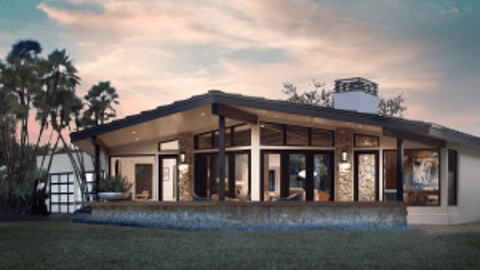At IBS: The 2022 forecast for home building and remodeling
Leading industry economists weighed in on the future of residential construction and remodeling today at the International Builders' Show in Orlando, Fla.
Labor shortages, material costs, and inflation are all on the radar as hurdles for the industry in 2022.
“Building material costs are up 21% compared to a year ago,” said Robert Dietz, chief economist of the National Association of Home Builders. “Their price and availability, along with persistent supply chain bottlenecks, remains the most urgent challenge for builders as they seek to boost production to meet rising demand.”
Builders continue to wrestle with ongoing labor shortages, with the government reporting more than 300,000 job openings in the construction industry in December. The NAHB said that it estimates the residential construction sector will need to add 740,000 workers per year just to keep pace with the industry’s growth, retirements and departures.
Inflation is also running well above the Federal Reserve’s 2% target rate and the Fed has signaled it will begin tightening monetary policy in March, generating upward pressure on mortgage rates.
The NAHB said it anticipates the Fed will conduct four 25-basis point federal funds rate increases in 2022 and that the average 30-year fixed rate mortgage will top 4% by the end of 2022.
“Higher mortgage rates combined with rising construction costs and a lack of construction workers will increase affordability headwinds in the year ahead,” said Dietz.
Taking into account the number of obstacles facing home builders, the NAHB expects modest single-family construction growth in the year ahead.
Single-family starts are expected to increase just 1.0% in 2022 to 1.13 million units and edge 1% lower in 2023 to a 1.12 million rate.
“While single-family growth slows in 2022 and 2023 and returns to a long-term trend, production will still be 26% higher than in 2019,” Dietz said.
Multifamily starts have been fueled by low vacancies and rising rents. The sector is anticipated to rise 6.3% from 2021 to about 496,000 units.
As multifamily building growth provides a lift to the market, overall housing production is expected to rise 2.5% this year to a 1.63 million annual pace.
Sales of new single-family homes are projected to total 830,000 in 2022, up 9.3% from last year.
Meanwhile, residential remodeling activity is expected to increase 6% in 2022 following a growth rate of 10% in 2021 as people continue to use their home for more purposes such as offices, schools and gyms.
The surge in home equity has enabled more home owners to finance remodeling projects that meet their needs, the NAHB said.
Where will growth occur?
New homes are needed where the population growth is highest, Frank Nothaft, chief economist at CoreLogic, said. The states that registered the highest net population growth between 2020 and 2021 were Texas, Florida, North Carolina, Arizona and Georgia.
These states with the highest net growth rate on percentage basis were Idaho, Utah, Montana, Arizona, and South Carolina.
“Population growth in the South and Mountain West will drive new-home demand,” said Nothaft. “Texas and Florida top the list and are the only two states to register a six-figure gain in population growth between 2020 and 2021, at 310,000 and 211,000, respectively. The top five metro markets in terms of new home sales during this period were Dallas, Houston, Atlanta, Phoenix and Austin.”
Between 2021 and 2030, Nothaft said he expects the largest population growth to occur in the Mountain West, Southeast and Texas.
For the critical entry-level and first-time home buyer market, Nothaft said that the states with the highest increase in population by 2030 for those between 20-to-29 years of age will be Idaho (15%), Utah (10%), Florida (9%), Arizona (8%), and Texas (8%).
Housing affordability
As material prices have risen sharply over the past year, David Berson, senior vice president and chief economist at Nationwide Insurance, said that Improving supply conditions should combine with solid job and income gains to propel growth forward at a strong pace over the middle of the year.
“As supply chains heal, Inflation should decelerate, but is likely to remain above-trend into 2023 as prior expansionary monetary policy continues to push services prices upward,” Berson said in his Monthly Economic Dashboard released on Jan. 28. “Fed tightening will eventually slow growth, but not until next year and beyond.”
Berson noted that home prices continue to rise at very high rates, with the S&P CoreLogic Case-Shiller U.S. National Home Price Index posting an 18.8% annual gain in November 2021.
“Strong demand, lack of supply and rising production costs are all acting to push house prices up at unsustainable rates,” Benson noted. “Rapid gains in prices and rents last year suggest that OER (owner’s equivalent rent, which measures how much more money a property owner would have to pay in rent to be equivalent to their cost of ownership) will climb this year – keeping the CPI from falling back to pre-Covid rates.”
While home prices averaged a record rate close to 19% in 2021, the economists differed on how high home price appreciation is headed in 2022.
“We expect the next 12 months that home prices will rise about 3.5%,” said Nothaft. “Demand should moderate because of affordability concerns – prices are up and mortgage rates are up.”
“The fact that home prices were up nearly 20% this year shows how much demand there is,” said Berson. “There will be excess demand for housing, at least for now, and we think home prices will rise between 9-10% this year, which would be half the pace of last year.”
Dietz said that NAHB’s forecast is for home prices to rise about 5% in 2022.
The International Builders Show runs Feb. 8 - Feb. 10 in Orlando.




